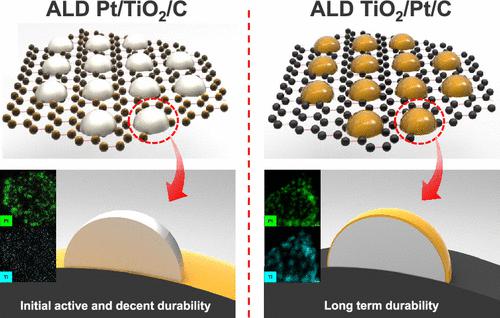当前位置:
X-MOL 学术
›
Chem. Mater.
›
论文详情
Our official English website, www.x-mol.net, welcomes your feedback! (Note: you will need to create a separate account there.)
In Situ Engineering of a Metal Oxide Protective Layer into Pt/Carbon Fuel-Cell Catalysts by Atomic Layer Deposition
Chemistry of Materials ( IF 8.6 ) Pub Date : 2022-06-21 , DOI: 10.1021/acs.chemmater.2c00928 Woo-Jae Lee 1, 2 , Susanta Bera 1 , HyunJae Woo 3 , Hyun Gu Kim 3 , Ji-Hu Baek 3 , Woongpyo Hong 4 , Jung-Yeon Park 4 , Seung-Jeong Oh 4 , Se-Hun Kwon 1, 3
Chemistry of Materials ( IF 8.6 ) Pub Date : 2022-06-21 , DOI: 10.1021/acs.chemmater.2c00928 Woo-Jae Lee 1, 2 , Susanta Bera 1 , HyunJae Woo 3 , Hyun Gu Kim 3 , Ji-Hu Baek 3 , Woongpyo Hong 4 , Jung-Yeon Park 4 , Seung-Jeong Oh 4 , Se-Hun Kwon 1, 3
Affiliation

|
Degradation of polymer electrolyte membrane fuel cell (PEMFC) systems has emerged as a critical issue. A thin metal oxide layer coated with Pt/carbon via ALD (atomic layer deposition) is one of the potential approaches for preserving electrochemical activity; however, the exact interfacial effects of metal oxide on enhancing PEMFC durability are unclear. Herein, interfacial engineering of the TiO2 layers within the in situ-synthesized Pt/carbon catalysts (Pt/TiO2/C and TiO2/Pt/C) was studied using fluidized bed reactor (FBR) ALD to investigate the exact effects of the catalysts. For the Pt/TiO2/C catalyst, the TiO2 layer was first conformally coated on the carbon surfaces, whereas for TiO2/Pt/C, the TiO2 layer was selectively formed on the Pt NP surface via the ALD mechanism. The Pt/TiO2/C catalyst has a higher Pt loading with suppressed micropores due to the introduction of the TiO2 layer on the carbon support, whereas the TiO2/Pt/C catalyst remained in the 2–3 nm mesopores. The electrochemical durability of both ALD catalysts is superior to that of the commercial Pt catalyst. Encapsulating the TiO2 layer on the Pt surface specializing in blocking Pt dissolution resulted in better long-term stability of the electrochemical characteristics compared to the stability of those of Pt/TiO2/C, which especially showed the better initial performance of the electrochemically active surface area, oxygen reduction reaction, and PEMFC single-cell performance. This study provides the direction and steps toward an efficient nanostructure design of metal oxide by ALD in most catalyst fields.
中文翻译:

通过原子层沉积将金属氧化物保护层原位工程转化为 Pt/碳燃料电池催化剂
聚合物电解质膜燃料电池 (PEMFC) 系统的降解已成为一个关键问题。通过 ALD(原子层沉积)涂覆 Pt/碳的薄金属氧化物层是保持电化学活性的潜在方法之一。然而,金属氧化物对增强 PEMFC 耐久性的确切界面影响尚不清楚。在此,使用流化床反应器 (FBR) ALD 研究了原位合成的 Pt/碳催化剂(Pt/TiO 2 /C 和 TiO 2 /Pt/C)中 TiO 2层的界面工程,以研究催化剂。对于 Pt/TiO 2 /C 催化剂,首先将 TiO 2层保形涂覆在碳表面上,而对于 TiO 2/Pt/C,TiO 2层通过ALD机制选择性地形成在Pt NP表面上。由于在碳载体上引入了 TiO 2层,Pt/TiO 2 /C 催化剂具有更高的 Pt 负载量和抑制的微孔,而 TiO 2 /Pt/C 催化剂保留在 2-3 nm 中孔中。两种 ALD 催化剂的电化学耐久性均优于商业 Pt 催化剂。与 Pt/TiO 2的稳定性相比,将 TiO 2层包封在Pt 表面专门用于阻止 Pt 溶解导致电化学特性的长期稳定性更好/C,尤其表现出更好的电化学活性表面积、氧还原反应和PEMFC单电池性能的初始性能。本研究为在大多数催化剂领域通过 ALD 设计金属氧化物的有效纳米结构提供了方向和步骤。
更新日期:2022-06-21
中文翻译:

通过原子层沉积将金属氧化物保护层原位工程转化为 Pt/碳燃料电池催化剂
聚合物电解质膜燃料电池 (PEMFC) 系统的降解已成为一个关键问题。通过 ALD(原子层沉积)涂覆 Pt/碳的薄金属氧化物层是保持电化学活性的潜在方法之一。然而,金属氧化物对增强 PEMFC 耐久性的确切界面影响尚不清楚。在此,使用流化床反应器 (FBR) ALD 研究了原位合成的 Pt/碳催化剂(Pt/TiO 2 /C 和 TiO 2 /Pt/C)中 TiO 2层的界面工程,以研究催化剂。对于 Pt/TiO 2 /C 催化剂,首先将 TiO 2层保形涂覆在碳表面上,而对于 TiO 2/Pt/C,TiO 2层通过ALD机制选择性地形成在Pt NP表面上。由于在碳载体上引入了 TiO 2层,Pt/TiO 2 /C 催化剂具有更高的 Pt 负载量和抑制的微孔,而 TiO 2 /Pt/C 催化剂保留在 2-3 nm 中孔中。两种 ALD 催化剂的电化学耐久性均优于商业 Pt 催化剂。与 Pt/TiO 2的稳定性相比,将 TiO 2层包封在Pt 表面专门用于阻止 Pt 溶解导致电化学特性的长期稳定性更好/C,尤其表现出更好的电化学活性表面积、氧还原反应和PEMFC单电池性能的初始性能。本研究为在大多数催化剂领域通过 ALD 设计金属氧化物的有效纳米结构提供了方向和步骤。



























 京公网安备 11010802027423号
京公网安备 11010802027423号